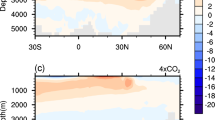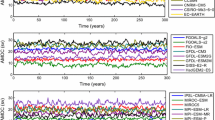Abstract
Observations, theoretical analyses, and climate models show that the dominant timescale of multidecadal variability of the Atlantic Meridional Overturning Circulation (AMOC) is related to westward temperature propagations in the subpolar North Atlantic, which is modulated by oceanic baroclinic Rossby waves or thermal Rossby waves. Here, we find major timescales of AMOC variability of 12–28 years and associated westward temperature propagations in the preindustrial simulations of 9 CMIP6/CMIP5 models. The comparison with observations shows that the models reasonably simulate ocean stratifications and baroclinic Rossby waves in the subpolar North Atlantic. The timescale of the oceanic baroclinic Rossby wave propagating on a static background across the basin overestimates the major timescale of AMOC variability. The dual effects of the mean flow on the AMOC timescale are then considered, involving the eastward advection and the additional westward propagation (i.e., thermal Rossby wave) induced by the northward mean potential vorticity gradient. We find that the AMOC major timescale is generally determined by the comprehensive effects of the baroclinic Rossby wave and the mean flow effects, in which the additional westward propagation plays a dominant role. Our results illustrate the importance of considering mean flow effects in the estimate of the dominant timescale of AMOC multidecadal variability.










Similar content being viewed by others
Data availability
The CMIP6/CMIP5 data are freely available at https://esgf-node.llnl.gov/search/cmip6/ and https://esgf-node.llnl.gov/search/cmip5/. The IPRC Argo plus Aviso altimetry data can be download from https://argo.ucsd.edu/data/argo-data-products/. The Levitus94 world-ocean atlas is available at https://iridl.ldeo.columbia.edu/SOURCES/.LEVITUS94/index.html. The WOA18 world-ocean atlas is available at https://www.nodc.noaa.gov/OC5/woa18/. Partial data of this study could be downloaded on this website: https://drive.google.com/drive/folders/1d9D16g0n7BiQpjjHndJBpPQCTRfZULMQ?usp=sharing.
References
Argo (2020) Argo float data and metadata from Global Data Assembly Centre (Argo GDAC). SEANOE
Armstrong E, Valdes P, House J, Singarayer J (2017) Investigating the Impact of CO2 on Low-Frequency Variability of the AMOC in HadCM3. J Clim 30(19):7863–7883
Årthun M, Wills RC, Johnson HL, Chafik L, Langehaug HR (2021) Mechanisms of decadal North Atlantic climate variability and implications for the recent cold anomaly. J Clim 34(9):3421–3439
Buckley MW, Marshall J (2016) Observations, inferences, and mechanisms of the Atlantic Meridional overturning circulation: a review. Rev Geophys 54(1):5–63
Buckley MW, Ferreira D, Campin J-M, Marshall J, Tulloch R (2012) On the relationship between decadal buoyancy anomalies and variability of the Atlantic meridional overturning circulation. J Clim 25(23):8009–8030
Chelton DB, DeSzoeke RA, Schlax MG, El Naggar K, Siwertz N (1998) Geographical variability of the first baroclinic Rossby radius of deformation. J Phys Oceanogr 28(3):433–460
Chelton DB, Schlax MG (1996) Global observations of oceanic Rossby waves. Science 272(5259):234–238
Cheng J, Liu Z, Zhang S, Liu W, Dong L, Liu P, Li H (2016) Reduced interdecadal variability of Atlantic meridional overturning circulation under global warming. Proc Natl Acad Sci 113(12):3175–3178
Chylek P, Folland C, Frankcombe L, Dijkstra H, Lesins G, Dubey M (2012) Greenland ice core evidence for spatial and temporal variability of the Atlantic Multidecadal Oscillation. Geophys Res Lett 39(9).
Colin de Verdière A, Huck T (1999) Baroclinic instability: an oceanic wavemaker for interdecadal variability. J Phys Oceanogr 29(5):893–910
Cunningham SA, Kanzow T, Rayner D, Baringer MO, Johns WE, Marotzke J et al (2007) Temporal variability of the Atlantic meridional overturning circulation at 26.5 N. Science 317(5840):935–938
Dijkstra HA, Te Raa L, Schmeits M, Gerrits J (2006) On the physics of the Atlantic multidecadal oscillation. Ocean Dyn 56(1):36–50
Feng QY, Dijkstra H (2014) Are North Atlantic multidecadal SST anomalies westward propagating? Geophys Res Lett 41:541–546. https://doi.org/10.1002/2013GL058687
Frankcombe L, Dijkstra H (2009) Coherent multidecadal variability in North Atlantic sea level. Geophys Res Lett 36(15)
Frankcombe L, Dijkstra H, Von der Heydt A (2008) Sub‐surface signatures of the Atlantic Multidecadal Oscillation. Geophys Res Lett 35(19).
Frankcombe LM, Von Der Heydt A, Dijkstra HA (2010) North Atlantic multidecadal climate variability: an investigation of dominant time scales and processes. J Clim 23(13):3626–3638
Gastineau G, Mignot J, Arzel O, Huck T (2018) North Atlantic ocean internal decadal variability: role of the mean state and ocean-atmosphere coupling. J Geophys Res Oceans 123(8):5949–5970
Griffies SM, Bryan K (1997) Predictability of North Atlantic multidecadal climate variability. Science 275(5297):181–184
Huck T, Verdière AC, de, Weaver A. J. (1999) Interdecadal variability of the thermohaline circulation in box-ocean models forced by fixed surface fluxes. J Phys Oceanogr 29:865–892
Johnson HL, Marshall DP (2002) A theory for the surface Atlantic response to thermohaline variability. J Phys Oceanogr 32(4):1121–1132
Kawase M (1987) Establishment of deep ocean circulation driven by deep-water production. J Phys Oceanogr 17(12):2294–2317
Killworth PD, Chelton DB, de Szoeke RA (1997) The speed of observed and theoretical long extratropical planetary waves. J Phys Oceanogr 27(9):1946–1966
Knight JR, Folland CK, Scaife AA (2006) Climate impacts of the Atlantic multidecadal oscillation. Geophys Res Lett 33(17)
Levitus S, Boyer TP (1994) World ocean atlas 1994. volume 4. temperature. National Environmental Satellite, Data, and Information Service, Washington
Levitus S, Burgett R, Boyer TP (1994) World Ocean Atlas 1994. Vol. 3, Salinity
Liu Z (1999) Planetary wave modes in the thermocline: Non-Doppler-shift mode, advective mode and Green mode. Q J R Meteorol Soc 125(556):1315–1339
Liu Z (2012) Dynamics of interdecadal climate variability: a historical perspective. J Clim 25(6):1963–1995
Locarnini M, Mishonov A, Baranova O, Boyer T, Zweng M, Garcia H et al (2018) World ocean atlas 2018, volume 1: Temperature
Ma X, Liu W, Allen RJ, Huang G, Li X (2020) Dependence of regional ocean heat uptake on anthropogenic warming scenarios. Science Advances 6(45):eabc0303
Ma X, Liu W, Burls NJ, Chen C, Cheng J, Huang G, Li X (2021) Evolving AMOC multidecadal variability under different CO2 forcings. Clim Dyn 1–18
MacMartin DG, Zanna L, Tziperman E (2016) Suppression of Atlantic meridional overturning circulation variability at increased CO2. J Clim 29(11):4155–4164
McCarthy G, Frajka‐Williams E, Johns WE, Baringer MO, Meinen CS, Bryden H et al (2012) Observed interannual variability of the Atlantic meridional overturning circulation at 26.5 N. Geophys Res Lett 39(19).
Moat BI, Smeed DA, Frajka-Williams E et al (2020) Pending recovery in the strength of the meridional overturning circulation at 26 N. Ocean Sci 16:863–874
Muir LC, Fedorov AV (2017) Evidence of the AMOC interdecadal mode related to westward propagation of temperature anomalies in CMIP5 models. Clim Dyn 48(5–6):1517–1535
Ortega P, Mignot J, Swingedouw D, Sévellec F, Guilyardi E (2015) Reconciling two alternative mechanisms behind bi-decadal variability in the North Atlantic. Prog Oceanogr 137:237–249
Owen GW, Willmott AJ, Abrahams ID, Mansley H (2005) The scattering of Rossby waves from finite abrupt topography. Geophys Astrophys Fluid Dyn 99(3):219–239
Rossby C-G (1939) Relation between variations in the intensity of the zonal circulation of the atmosphere and the displacements of the semi-permanent centers of action. J Mar Res
Sévellec F, Fedorov AV (2013) The leading, interdecadal eigenmode of the Atlantic meridional overturning circulation in a realistic ocean model. J Clim 26(7):2160–2183
Sévellec F, Fedorov AV (2015) Optimal excitation of AMOC decadal variability: links to the subpolar ocean. Progr Oceanogr 132:287–304
Sicre M-A, Yiou P, Eiríksson J, Ezat U, Guimbaut E, Dahhaoui I et al (2008) A 4500-year reconstruction of sea surface temperature variability at decadal time-scales off North Iceland. Quatern Sci Rev 27(21–22):2041–2047
Sutton RT, Hodson DL (2005) Atlantic Ocean forcing of North American and European summer climate. Science 309(5731):115–118
Taylor KE, Stouffer RJ, Meehl GA (2012) An overview of CMIP5 and the experiment design. Bull Am Meteor Soc 93(4):485–498
Te Raa LA, Dijkstra HA (2002) Instability of the thermohaline ocean circulation on interdecadal timescales. J Phys Oceanogr 32(1):138–160
Tulloch R, Marshall J, Smith KS (2009) Interpretation of the propagation of surface altimetric observations in terms of planetary waves and geostrophic turbulence. J Geophys Res 114:C02005
Vianna ML, Menezes VV (2013) Bidecadal sea level modes in the North and South Atlantic Oceans. Geophys Res Lett 40(22):5926–5931
Wu S, Liu Z-Y (2020) Decadal variability in the North Pacific and North Atlantic under global warming: the weakening response and its mechanism. J Clim 33(21):9181–9193
Yang Y, Wu L, Fang C (2012) Will global warming suppress North Atlantic tripole decadal variability? J Clim 25(6):2040–2055
Zhang J, Zhang R (2015) On the evolution of Atlantic meridional overturning circulation fingerprint and implications for decadal predictability in the North Atlantic. Geophys Res Lett 42(13):5419–5426
Zhang L, Wang C (2013) Multidecadal North Atlantic sea surface temperature and Atlantic meridional overturning circulation variability in CMIP5 historical simulations. J Geophys Res Oceans 118(10):5772–5791
Zhang R, Delworth TL (2006) Impact of Atlantic multidecadal oscillations on India/Sahel rainfall and Atlantic hurricanes. Geophys Res Lett 33(17)
Zhang R, Sutton R, Danabasoglu G, Kwon Y, Marsh R, Yeager SG et al (2019) A review of the role of the Atlantic meridional overturning circulation in Atlantic multidecadal variability and associated climate impacts. Rev Geophys 57(2):316–375
Zweng M, Seidov D, Boyer T, Locarnini M, Garcia H, Mishonov A et al (2019) World ocean atlas 2018, volume 2: Salinity
Acknowledgements
This work was supported by the National Natural Science Foundation of China (42141019, 41831175, 91937302, and 41721004) and the Second Tibetan Plateau Scientific Expedition and Research Program (2019QZKK0102). Xichen Li is supported by the National Natural Science Foundation of China (Grant No. 41976193 and 42176243).
Author information
Authors and Affiliations
Corresponding author
Ethics declarations
Conflict of interest
The authors have no competing interests to declare that are relevant to the content of this article.
Additional information
Publisher's Note
Springer Nature remains neutral with regard to jurisdictional claims in published maps and institutional affiliations.
Rights and permissions
Springer Nature or its licensor holds exclusive rights to this article under a publishing agreement with the author(s) or other rightsholder(s); author self-archiving of the accepted manuscript version of this article is solely governed by the terms of such publishing agreement and applicable law.
About this article
Cite this article
Ma, X., Huang, G., Li, X. et al. The potential mechanisms of the dominant timescale of AMOC multidecadal variability in CMIP6/CMIP5 preindustrial simulations. Clim Dyn 60, 2131–2145 (2023). https://doi.org/10.1007/s00382-022-06440-9
Received:
Accepted:
Published:
Issue Date:
DOI: https://doi.org/10.1007/s00382-022-06440-9




